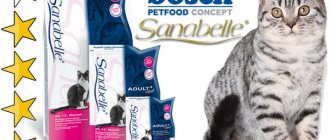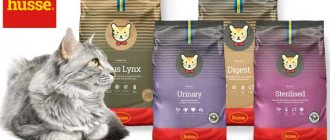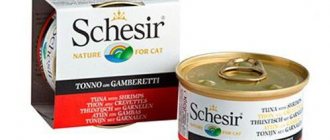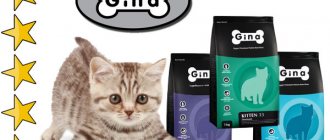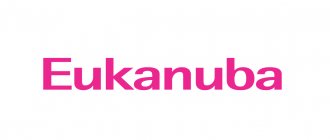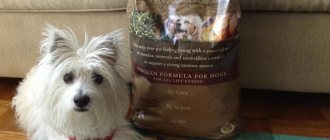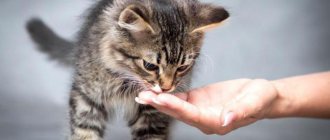Review of Kitiket cat food
Every owner dreams of his cat living a long and happy life without disease or suffering, so the choice of food is very important. Everything depends on nutrition - growth, development, the functioning of organs and systems of the body, immunity, etc. More and more often you can hear negative remarks about Kitekat food, but store shelves are constantly replenished with this product. Of course, the cat’s owner will decide on choosing this food, but first you need to find out everything about this product.
Price category
Reviews of dry “Kitekat” make you smile when you read how good the cat looks when eating this food. The coat is shiny, well-fed, and simply radiant with health. And most importantly, the owner does not have to spend much. The food is quite cheap.
A package of dry food weighing 400 grams will cost the buyer around 85 rubles.
800 grams of “balanced and healthy” food costs about 120 rubles.
For 250-260 rubles you can purchase a package weighing 1.9 kg.
For those who do not want to regularly go to the store to buy food for their pet, the manufacturer offers bags weighing 15 kg. The cost of such a bag is about 2000 rubles.
One bag of pouch, which weighs 85 grams, costs from 12 to 18 rubles. Wet food in an iron can – 83-90 rubles per 400 grams.
Kitiket food for cats
Kitekat is a world famous brand of cat food. This food is sold not only in pet stores, but also in regular supermarkets. The manufacturer assures that Kitekat food is the most balanced and healthy.
Kitekat brand food is sold in almost every store
Who is the manufacturer
Kitekat cat food is manufactured by Mars Inc. This is the largest corporation in the world, which has several branches. Pet products are produced by the Mars Petcare division. The organization's head office is located in Brussels (Belgium), but there are production factories in almost 50 countries around the world.
Mars Petcare has 42 brands (some of which are worth billions of US dollars), for example:
- "Pedigree"
- "Whiskas"
- Royal Canin.
- "Kitekat"
- "Banfield"
- "Caesar"
- "Nutro" (Nutro).
- "Sheba"
- "Chappi"
- "Catsan"
- "Frolic"
- "Perfect Fit"
- "Greenies" and others.
Mars Inc is a global leader in food and animal nutrition.
What class does it belong to?
There are four classes of animal feed:
- economy class;
- premium class;
- super premium;
- holistic class.
Any of these classes can include both dry and wet food. This division has been adopted by the Association of Veterinarians, but it is conditional. Often the manufacturer declares a class to which the product is quite difficult to classify. "Kitiket" belongs to economy class.
Table: how different classes of food differ
"Kitiket" is one of the most budget-friendly cat foods
Pros and cons of Kitekat food
Kitiket is selling out quickly. There is an explanation for this:
- reasonable price (even an owner with a very low budget can buy a package of food for his cat);
- accessibility (you don’t need to go to the other end of the city to buy this food, because it’s probably in the next store);
- popularity (many people trust a brand that is actively advertised on television);
- a wide selection of flavors (even the cheapest food can be bought with flavors like fish, chicken, meat, etc.).
Economy class food is often criticized by breeders and veterinarians due to the following disadvantages:
- This food contains very little meat, part of the protein is obtained from plant materials, so the food cannot be called ideally balanced;
- “Kitiket” contains dyes, flavors and preservatives of synthetic origin;
- Each series of food contains allergens (for example, brewer's yeast);
- there is no line of food for kittens;
- no medicinal feed.
One of the advantages of Kitiket food is its wide range of flavors.
basic information
Kitiket is manufactured by the Mars company, which is one of the largest corporations producing inexpensive cat food. The manufacturer assures that dry food and jelly have a balanced diet and include various microelements and vitamins that the animal needs for proper development.
When choosing Kitiket for a pet, you should remember that reviews from experienced breeders about it are mixed. Some claim that cats kept on dry food for a long time developed urolithiasis, the treatment of which is somewhat difficult. While other pet owners note that their animals have not had any diseases for 10 years or more. The Mars company states that all their food is manufactured using the same technology, ensuring excellent quality of such products, which are offered to customers at affordable prices.
It is difficult to obtain accurate information about the composition of Kitekat food. The packaging only indicates the total content of protein components, which can scare off many experienced cat owners who closely monitor their pet’s diet. In Kitiket, the amount of animal protein is indicated vaguely, so it will be difficult to draw a conclusion about its benefits.
Assortment and features of feed
The manufacturer offers its customers two types of products:
- dry food (400 g, 1 kg, 2.2 and 13 kg);
- wet food in the form of spiders (85 g each);
- canned food in cans (100 g each).
Dry food Kitekat
Dry food is currently produced in five series:
- "Meat Feast"
- “Assorted chicken and fish.”
- "Chicken".
- "Fisherman's Catch"
- "Veal".
Photo gallery: dry food "Kitiket"
Composition of Kitekat dry food
Kitiket dry food contains the following ingredients:
- meat and offal (beef, chicken, fish, liver or rabbit);
- protein plant extracts;
- cereals and vegetables;
- animal and vegetable fats;
- Brewer's yeast;
- vitamins (A, D, E, B1, B2, B6, B12, K, etc.);
- minerals (calcium, phosphorus);
- food colors, flavors.
The food packaging indicates the total amount of all protein components, and there may be a minimum amount of meat (for example, 4%). Knowing this can scare away cat owners, but on the other hand, a cat does not necessarily need fresh meat, the main thing is a sufficient amount of animal protein. But here some indicate the composition in such a way that the exact origin of the protein is “blurred”. In this case, the presence of carbohydrates may not be indicated at all.
The composition of the feed is not always accurately and in detail indicated on the Kitiket packaging.
Table: nutritional value of feed
The energy value of 100 g of such food is approximately 330 kcal, so the manufacturer calls its product a complete food.
Kitekat wet food
Canned food "Kitiket" is presented in several series:
- “Homemade lunch” (rabbit, fish, beef, liver, chicken) - canned food.
- “Juicy pieces” (with rabbit, turkey, chicken or beef in jelly) - pauchi.
- “Juicy pieces” (with rabbit, turkey, fish, chicken or beef in sauce) - pauchi.
Photo gallery: Kitiket wet food
Composition of wet food
Kitekat canned food consists of the following ingredients:
- Meat, offal and flour of animal origin.
- Cereals and vegetables.
- Minerals and vitamins (A, E, D).
- Preservatives.
Table: nutritional value of canned food
The energy value of 100 g of Kitiket wet food is 70 kcal.
The manufacturer of wet food "Kitiket" does not indicate the complete composition
Does Kitiket have medicinal food?
The brand does not have medicinal (veterinary) food. All Kitekat products are designed for everyday nutrition of healthy adult cats from 1 year of age.
Treats from Kitekat
The manufacturer does not produce individual treats. As "special" foods, single lines are sometimes produced, for example:
- pouches “Favorite Portion”;
- pouches “Simple and tasty”, etc.
I feed my cats natural food, but sometimes I buy well-known wet food as a treat. My cats don’t disdain, but since I pamper my animals no more than once a week, they don’t have time to get used to juicy canned food.
Photo gallery: special series of feeds
Some feeding recommendations
The animal must be accustomed to the Trainer food gradually, as with any dry food, although the transition period passes quickly. If the animal is accustomed to new food, then you can take a product with a different taste. A one-time norm should be established and strictly observed, and the cat should not be allowed to pass it on. Veterinarians advise choosing combined feeding: alternating dry granules with a wet formula and ordinary food. Such food, in their opinion, is ideal for an animal that needs a diet: it does not contain a large percentage of fat
The components of the mixture stabilize the weight of the four-legged
It is important that the cat always has water in a separate bowl, but this product does not cause a “burning thirst”, as happens with cheap food
How Kitekat food affects your pet's body
It is believed that cheap food can do nothing but harm to a cat. This is explained by the characteristics of the composition:
- Products processed from animal components (bone meal, feathers, hooves, beaks, etc.) may be of too low quality.
- Dyes, preservatives and other artificial ingredients poison the body.
- Corn and yeast can cause allergies.
- The food contains flavorings and taste enhancers, which means that the cat can get used to the food.
Many cat owners who fed their pets “Kitiket” attribute all their “sins” to this food when the animal gets sick. Veterinarians strongly recommend feeding their patients exclusively high-grade food. But this question can be looked at from the other side:
- Cheap ingredients (offal) are normal food for cats. In the wild, they feed on mice, birds, etc. Such components are valuable for the presence of protein.
- Dyes are also found in some expensive foods, and all food dyes are allowed by different standards. And preservatives are absolutely necessary to ensure that the food does not spoil.
- Allergens are sometimes found in holistic foods. The characteristics of the composition are determined by the manufacturer himself, especially since not all cats have allergies.
- Flavorings are needed not to cause addiction, but to give the animal an appetite, because it affects digestion.
I often hear from cat owners phrases like “Kitiket is poison”, “It’s all chemicals”, “They add drugs to this food”, etc. I think this is all exaggerated. Buying cat food is similar to choosing human food. For example, if a person does not have money for a piece of fresh boneless beef, then he will buy inexpensive sausages or sausage. Sausages, for example, also contain dyes, flavors, preservatives and the same by-products. People understand that it is not very useful, but they still buy it. So does cat food. Everyone buys food within their budget.
Despite a large number of angry reviews, cat owners continue to buy these products
If economy class food is produced and it is permitted by law, it means that it does not have to be harmful to health. But you need to remember to follow the feeding rules:
- You cannot mix natural food and ready-made food (as well as food of different brands). Each food is balanced in its own way, and when mixed, this balance is disrupted. For example, you cannot feed your cat “Kitiket” and raw fish - this leads to severe attacks of urolithiasis.
- If we are talking about dry food, then you need to take a more serious approach to the drinking regime (there should be plenty of water, otherwise it will have a bad effect on digestion and kidney function).
- There is no need to “stuff” your cat with vitamins and various supplements without the recommendation of a veterinarian (this also upsets the balance).
- You need to carefully follow the manufacturer's recommendations (volume and number of feedings) so that your pet does not have to be fed with natural food.
- Nursing and pregnant cats need to be fed more often to prevent them from starving.
When is it contraindicated to give them to a cat?
There are animals that are not recommended to be fed with such food:
- cats with urolithiasis or kidney failure;
- kittens under 1 year of age (they need a differently balanced diet);
- cats and cats prone to allergies.
My sister's cat has urolithiasis. For two years he ate mainly fish, which led to the development of the disease (according to the veterinarian, fish is one of the provoking foods, as it contains a lot of phosphorus). The veterinarian prescribed treatment and recommended switching the cat to complete industrial food. My sister bought Kitiket, but experts advised replacing the food with a veterinary diet (super premium food).
Kitekat food is contraindicated for kittens, allergic cats and animals with urolithiasis
Preservatives
Of course, any feed contains substances that ensure long-term storage of the product. Possible preservatives include:
- ascorbic acid;
- benzoic acid,
- butylated hydroxyl anisole (BHA),
- butylated hydroxyl toluene (BHT),
- calcium ascorbate,
- lemon acid,
- ethoxyquin,
- potassium sorbate,
- sodium bisulfate,
- tocopherols.
It is the manufacturer's responsibility to indicate the preservative used.
- ascorbic acid;
- benzoic acid,
- butylated hydroxyl anisole (BHA),
- butylated hydroxyl toluene (BHT),
- calcium ascorbate,
- lemon acid,
- ethoxyquin,
- potassium sorbate,
- sodium bisulfate,
- tocopherols.
KiteKat for cats
I am not a fan of feeding cats KiteKat food. This food can cause illness in the animal. The main advantage of this food is its availability, as well as the variety of tastes. But it is the low price that explains its “to put it mildly” harmful composition. There is nothing related to natural meat in it, but is made only from animal waste, dyes, preservatives, as well as wheat flour and yeast, which are allergens. In my practice, there have been cases when animals eating this food developed urolithiasis, and also had problems with hair, constipation and diseases of the gastrointestinal tract. The food must be balanced in composition and contain useful substances.
If we compare kitiket with human food, it is at the level of our doshirak. It satiates the stomach, but does not provide anything valuable or beneficial to the body. Well, if nothing harmful, many people develop sores and exacerbations. I, too, had a period of stress in my life with money, so I had to stuff the cat with kitiket, we ourselves practically sat on the same thing, ate doshirak. But the cat could not tolerate kitiket with beef, either in liquid or dry form, she simply vomited. Either the additives were specific, or indigestion. She ate the rest of the food normally. Occasionally, of course, she fed her with leftovers from the table: sour cream, fish. But after three months I was horrified, I realized that the cat had scabs all over her body, she stroked and felt all these crusts. The doctor said that there is a high probability that the kitiket is oversaturated with the chemical composition, and it turns out there is plenty of chemistry in it. All these scabs were itching, and the cat tore herself bleeding. There was no time for saving anymore. I had to not only change the food, but also treat the cat. They stopped giving dry food altogether, only natural food. And only a month later the condition improved. We no longer risk taking kitiket, even for variety, in any form. If you have to leave the animal at home alone for several days, there is now a holistic specialist at home for this case.
I succumbed to the general negativism against kitite, I also changed the food to a more expensive one, I hope it was of high quality, although I fed the cat this dry food for almost five years. And we bought liquid kitiket, I liked it so much that this portion was disposable, the cat ate it right away and there was no need to store anything in the refrigerator. Of course, the composition is not the most complete due to the fact that cereals come first, and then meat. But I also gave my cat fresh chicken and liver, maybe thanks to this the balance was maintained. But many people say that there is only waste instead of meat. Judging by the price, it is quite likely. But judging by the cat, I didn’t see any health problems. True, again, according to reviews from veterinarians, the harmful reaction from this food is cumulative; the side effects do not appear immediately, but after a while, mainly in the form of some kind of chronic disease. Therefore, I decided not to ruin the cat’s health.
I fed the cat Purina, Hills, Royal, Happy Cat, Friskies, Our brand and Kitekat - I honestly didn’t see the difference. Just as a cat had difficulty going to the toilet on liquid food, she went to the toilet on dry food. As soon as we switched to natural food - porridge with liver, fish, chicken eggs - the cat began to go to the toilet normally. The last food we bought was kiteket, so as not to throw it away, I put it in a vase and made decorations. Colored crackers are cool. Tastes like dried corn porridge. I don’t see any difference from food for 500 rubles and food for 70 rubles, they all leave food problems. In my opinion, it is better not to feed this. The cat had a tasty meal, but was tired of cleaning up traces of its vital activity.
Kitekat for cats is the cheapest food that is widely known. Everyone who feeds a cat food from 500 rubles. per kilo, always compares the benefits of his own food with the given food. Not to say that Kitekat does not have its own advantages: 1. economical price; 2. nutritional value; 3. taste. But if you compare it with a full-fledged diet, you can see a mountain of minuses: 1. inferior composition; 2. cheap ingredients; 3. bad package without fastener; 4. cloudy composition with marketing changes. But everyone agrees that pensioners should be left with some niche of cat food. Not every granny with a pension of 10 thousand will run to buy her Barsik food for 4 thousand for a large pack. My grandmother feeds her horde with kitekats in addition to minced meat, fresh oats, cottage cheese, and in the summer the cats are on a dacha walk and I’m willing to bet whose cats are healthier, those that always eat premium or occasionally eat economy and natural food.
Of all the economy foods, the cat likes this food the least. This applies to drying, canned food, and wet food. That’s why I don’t buy it all the time, I buy pouch bags occasionally as a treat, and dry it by coincidence. In fact, there is no benefit from the food, the composition is completely empty. But when finances do not allow feeding holistically, I combine Kitekat with more expensive food. The manufacturer does not fully disclose the composition, but there is definitely no meat, but it is full of offal, soy, corn and bone meal, and grains come first. For some reason, the food was even salted, although cat food is not generally salted. But with all this, according to the manufacturer, the food does not contain flavor enhancers and artificial flavors, but it is full of preservatives and thickeners, but it has added vitamins and taurine. It turns out there is no harm in fattening either, but you need to watch it carefully with your pet, cats react very differently to Kitekat. And you definitely shouldn’t make it the basis of your diet. I didn’t notice the strong addiction to the food that everyone is talking about. There is also no increased appetite, the cat does not attack the food, sometimes the bag of canned food does not finish at all. He does not like huge pieces, which, after opening in case of high humidity, swell even more. Opened canned goods last only a few hours, then they begin to deteriorate. Dry food is also not very convenient to eat, it has huge granules, more like dog food. The smell of the food is strong and completely unnatural. If a cat washes itself after eating, it literally stinks of food for a while. Nevertheless, I don’t completely give up food, sometimes it helps out a lot, its price is one of the lowest on the market.
Can I cook it myself?
Making your own food for your furry pet is a fairly simple procedure consisting of the following steps:
- Mix the pre-prepared ingredients and grind them through a meat grinder. Beat the resulting minced meat with a blender to a dough-like consistency.
- Place the mixture on a baking sheet, the bottom of which is lined with parchment paper. Dry it in the oven at a temperature not exceeding 100 degrees. At the same time, you need to make sure that the mixture does not dry out. Usually the procedure takes no more than 20-25 minutes.
- Taking the dried mass out of the oven, cut it into small pieces, and then place it back in the oven for 1.5 hours. Periodically, the contents of the baking sheet should be checked for readiness by piercing it with a toothpick. If the mass turns out to be dry, this means that the mixture is completely cooked and can be removed from the oven.
The finished food should be cooled at room temperature. Only when it has completely cooled down should you pour it into a container with a tight-fitting lid. It is recommended to store the granules in the refrigerator. You can prepare food from any food that your cat is allowed to eat. The main thing is that its composition is balanced. The table provides information about products from which you can prepare food for your furry pet.
| Food recipe | Ingredients | Cooking method |
| Beef or chicken |
| The meat and egg are boiled until fully cooked. The cereal is poured with boiling water for 10-15 minutes. The components are thoroughly mixed. |
| Beef heart |
| The offal is boiled until fully cooked. All ingredients are mixed. |
| From chicken hearts |
|
Let's talk about Kitekat: what kind of food is it?
Kitekat food is produced by the international corporation MARS. She made sure that the brand became recognizable and was on the shelves in all stores. Own developments, production facilities and many years of experience of the parent company in promoting its own products have allowed TM Kitekat to occupy the minds of our citizens.
The main character of the good videos created in support of the brand also played an important role in this. Boris the cat - charming, playful and bursting with health - could not help but provoke a response from the audience. He became the main symbol of the brand and gave it unprecedented popularity.
Despite the fact that opinions on the quality of food differ, it forms the basis of the diet of tens of thousands of seals in our country. And this is not surprising: Kitekat has occupied a place of honor on store shelves for many years in a row. The food is available and approved by the Association of Veterinary Practitioners, which means it contains everything you need to keep your pets healthy. Reviews from veterinarians and experienced owners on the Internet speak for themselves. And we will definitely address them as part of this review.
How to replace "Trainer"
Cat food cat chow / cat chow: reviews from veterinarians and owners, composition
Sometimes it happens that the usual food is not available in the store, or the owner does not have the opportunity to go for the right product. In such cases, it may be necessary to replace the feed. Veterinarians do not recommend replacing cat food with a product of another class (for example, it is not advisable to replace holistic food with premium food, etc.). But the owner of the animal may encounter financial difficulties, then he has to look for a more budget-friendly option. The cat may also have an intolerance to the Trainer food (due to certain components), in which case it will need to be replaced. Instead of Trainer food, you can choose a product of the following classes:
- Premium (Brit Premium, Organix, Science Plan, Eukanuba, Night Hunter, etc.).
- Super premium (1st Choice, Leonardo, Sanabelle, Monge, Savarra, Almo Nature, etc.).
- Holistic (Pronature Holistic, Acana, Go Natural, Now, etc.).
Comparison table: food to replace “Trainer”
| Feed class | Type of feed | Name | Flavor options | Packing | Protein included | Unwanted Components | Veterinary rulers | Kitten food | Price |
| Premium | Dry and wet | Brit Premium | Beef, duck, chicken, turkey, salmon, trout | 100, 300 g, 1.5 kg, 8 kg | Up to 40% | Corn | There are series for cats of different ages, sterilized and with body characteristics | Kitten - for kittens up to 1 year | From 445 rubles (1.5 kg) |
| Science Plan | 85 g, 300 g, 1.5 kg, 2, 10 kg | From 660 rubles (1.5 kg) | |||||||
| Superpremium | Dry | 1st Choice (“First Choice”) | 350 g, 1.5 kg, 2.72 and 5.44 kg | — | “Healthy start” – from 2 months | ||||
| Dry and wet | Leonardo ("Leonardo") | duck, chicken, turkey, fish, liver, meat, shrimp, heart | 400 g, 2 and 7.5 kg, 17 kg | Up to 65% | Corn, brewer's yeast, starch | There are series for cats of different ages and with physiological characteristics | Kitten (for kittens from 5 months and pregnant cats) | ||
| DryDry | Sanabelle (“Sanabel”) | Poultry (including ostrich), meat, fish, vegetables | 400 g, 2 and 10 kg | Animal protein - 32% | Potato protein | There are separate therapeutic and preventive lines for cats of different ages and breeds | Kitten (for kittens up to 1 year) | From 944 rubles (1.5 kg) | |
| Holistic | Pronature | Turkey/cranberry, salmon/rice, duck/orange, sweet potato | 340 g, 2 and 2.72 kg, 5.44 and 6 kg | Up to 57% | — | There is food for cats of different ages and those living outdoors or indoors | From 350 rubles (0.34 kg) | ||
| Acana | Lamb, chicken, turkey, duck, ocean fish | 340 g, 1.8 and 5.4 kg, 11.4 kg | Up to 80% | — | There are preventative hypoallergenic foods | From 1400 rubles (1.8 kg) | |||
| Dry and wet | Go Natural | Duck, chicken, turkey, salmon, trout | 230 g, 1.82 and 3.63 kg, 7.26 and 11.35 kg | From 48% | Potatoes, peas |
Types of Kitekat rations
Kitekat produces dry and wet cat food. Dry rations are packaged in bags of different sizes from 150 g to 15 kg.
The food can be found on store shelves in five varieties:
- Fisherman's catch.
- Meat feast.
- The chicken is delicious.
- The veal is delicious.
Single servings of Kitekat wet food are produced in pouches:
- in jelly - with beef, chicken, rabbit, fish and lamb;
- in sauce - with duck, beef, chicken, lamb, rabbit.
"Felix" (in bags)
What is this brand of cat food made from? This is economy food. It contains meat and its processed products (4% chicken, 4% lamb). However, what kind of meat is included and how much of it is unknown. In addition, there is a vegetable protein extract, fish and its products, minerals, dyes, sugars, and vitamins.
What is this brand of cat food made from? This is economy food. It contains meat and its processed products (4% chicken, 4% lamb). However, what kind of meat is included and how much of it is unknown. In addition, there is a vegetable protein extract, fish and its products, minerals, dyes, sugars, and vitamins.
Kitekat feed composition
The Kitekat line of dry food is distinguished by the fact that in the list of ingredients it contains cereals first, followed only by meat and offal. Dry food contains protein plant extracts, dehydrated vegetables, fats of animal and plant origin, as well as mineral compounds and vitamins.
The packaging provides data only on the analytical composition. It is difficult to find out the exact content of each of the components, but this state of affairs in general has been in the animal food market for a long time.
Kitekat wet food consists of high quality meat and offal purchased only from trusted suppliers. In addition, the recipe contains cereals, oils, mineral compounds, and vitamins. Kitiket food lines contain taurine, an essential amino acid that your pet’s body cannot produce on its own, so it must be obtained in sufficient quantities from the diet. This element ensures sharp vision and proper functioning of the cardiovascular system.
Wet spiders are recommended by veterinarians as a daily addition to the cat’s “menu”: they are higher in calories. For example, each piece of Kitekat wet food contains 71% meat ingredients - what a predator, even a domesticated one, needs.
Balanced – Innova Cat and Kitten
The food can be called almost perfectly balanced. The protein here is only of animal origin. In order for the cat to be satisfied and receive everything it needs for full development, it needs a small portion. This makes it possible to rationally use rather expensive packs. Experts note that the composition is completely free of harmful ingredients and components that can cause harm.
However, the food is very expensive. In addition, it is not available for free sale and can only be purchased through official representatives on Internet resources. Veterinarians also note that the packs intended for daily use contain a lot of animal protein. Therefore, this menu is not suitable for neutered cats. It is necessary to consider a special treatment series with a reduced protein content.
Pros and cons of brand lines
The popularity of Kitekat food is primarily due to the human factor. Bright bags and a proven brand inspire trust and loyalty. However, if we put aside the emotional component and turn only to the facts, we understand that such a prevalence of food is also due to the fact that it is accessible and perfectly suitable for most pets.
What categorical advantages does this food have?
Let's look at them in a little more detail:
- relatively inexpensive;
- widely known;
- present on the shelves of most stores;
- offers a large selection of flavors for adult cats - even picky eaters and gourmets will find something “of their own” among these options.
Kitekat also has disadvantages - however, we will not deny that every manufacturer has them. Let's give some examples:
- the manufacturer does not produce specialized lines: for kittens, elderly pets, medicinal or dietary;
- Kitekat is shrouded in a lot of myths and speculation about its composition, but popularity always has two sides.
Let's summarize
We read reviews from veterinarians about Kitekat. We examined in detail the composition of the feed, found out its advantages and disadvantages. Let's remember the main points of the article:
- “Kitekat” is a Russian-made food. It is made in the village of Stupino, in the Moscow region.
- The manufacturer does not indicate the exact composition of the product and is silent about the number of declared ingredients.
- The food contains preservatives, artificial colors and flavor enhancers.
- One of the advantages of “fast food” for cats is the price. The second is a pretty decent choice.
- You should not feed your pet with Kitekat brand food. This is an economy class product that will do more harm to the animal than good.
Customer reviews about Kitekat food
On trust sites with reviews, buyers share their opinions and, as you can see, they are very contrasting. However, many negative reviews are based on the fact that the cat either did not like the taste or had an allergic reaction to the protein. The latter case cannot be an argument in favor of low quality, because the reaction to the same component (protein) in any other food will be no less obvious.
Here are examples of some reviews:
There are also more detailed reviews about the food, which you can see using the links below.
Conclusion
The advantages of this food include its price, availability and variety, but its composition and effect on the animal are completely negative. If you ask a question on the Internet and look at the reviews of veterinarians who have experience in saving cats that have become ill due to eating this food, you will see many negative suggestions.
And reviews of Kitekat cat food are generally negative: angry cat owners literally curse unscrupulous manufacturers. So learn how to wean your cat off cheap food.
It’s up to you to decide whether to feed Kitiket or not, but remember the majority of negative reviews, and if you yourself gave this food to a cat, then tell us about your experience...
Reviews from veterinarians about Kitekat
You can have different attitudes to the reviews left by the owners: after all, the selection of food is a very individual matter. But it’s not easy to challenge the reviews of nutrition experts - here those who know exactly what food should form the basis of your furry’s diet get down to business. We have collected several reviews from veterinarians who shared their opinions about the Kitekat food lines.
Having extensive experience behind me, I can say one thing: ideal food simply does not exist. Any bag, even at a huge price, may simply not suit your pet, because their digestion and body characteristics are different. However, if we look at the facts about the basics of cat nutrition, we can draw a simple conclusion - Kiteket food has a fairly balanced composition and can be the main diet for every day.
Nutritional value, the presence of a satisfactory protein content, fats, grains and vitamins in the composition - all this ensures the high nutritional value of these diets. R. Solomonova, veterinarian
At work I heard a lot of reviews about economy class food. First of all, I note that the division into classes is quite incorrect, especially considering that the division is made by price category.
For example, Kitekat food, despite its low cost, is characterized by a composition that meets existing pet nutrition standards. After analyzing the ingredients, we can say that this food cannot harm your health. However, it is able to maintain the pet’s health and immunity, which means it can be recommended on a permanent basis. I. Reutova, veterinarian
Flaws
According to reviews, Kitekat dry food has a number of significant disadvantages.
Incomprehensible composition. We talked about this above, we won’t repeat it.
The basis of a cat's health is a balanced diet. What happens when she is fed cheap food? Internal organs are destroyed. This is not visible at first. But the cat cannot say. Visible signs include hair loss, thinness, and skin allergies, which manifest as small pink or red rashes on the ears. Another evidence that the food is not suitable for the animal is constant vomiting of undigested product.
The presence of preservatives and flavor enhancers, although this is not particularly advertised. Why are flavor enhancers bad? Because they are addictive.
Imbalance. What kind of balance can we talk about if the manufacturer conceals the composition of the produced feed?
